Archaeology and Ancient History
In the Footsteps of Caesar: the archaeology of the first Roman invasions of Britain
Julius Caesar and the Roman base at Ebbsfleet, Thanet, Kent
August 23rd 55 BC: Britain invaded
On 23 August 55 BC Julius Caesar invaded Britain. Within a month he was gone. Although Caesar's army - less than 10,000 strong - did not campaign beyond east Kent, the invasion caused a sensation in Rome. By invading Britain, Caesar had crossed beyond the world known to Romans – what they called the orbis terrarum – and brought the inhabitants of Britain under the rule of Rome.
Victory in 55 BC was achieved by defeating the Britons in battle and receiving their surrender. There was neither the need nor desire to leave an army of occupation. Glory was won by planting the flag, not by leaving boots on the ground. The audience that mattered to Julius Caesar was in Rome and the way the news of his conquest was received can be compared to the reaction of the European 'discovery' of the 'New World' in the 15th century AD.
Going beyond the known world was one of the reasons why that year Caesar was awarded the longest ever public thanksgiving in Roman history.
July 5th 54 BC: Caesar returns
Caesar returned to Britain within a year. This time he came with a much larger force; about 20,000 legionaries and cavalry. The reason Caesar gave for his return was that in the winter of 55–54 BC a prince of the British tribe the Trinobantes had fled to him in France to ask for his protection. That prince was called Mandubracius and his father had been killed by a leader called Cassivellaunus.
By returning to Britain Caesar was protecting a tribe who had asked for the help of Rome. This request made it a ‘just war’ or bellum iustum. But Caesar also had his own reasons for returning to Britain: success there brought him immense glory and prestige in Rome.
Caesar in Britain: 54 BC
Caesar's account describes how he won two battles within a days' march of the coast, before fording the Thames and marching in search of Cassivellaunus, whose territory lay north of the Thames. Cassivellaunus had been chosen by all the British tribes to be their supreme commander in their fight against the Romans.
Caesar makes it clear that the Roman army marched into or close to the territory of the Trinobantes. They are thought to be the tribe who later authors called the Trinovantes, who lived in the area of modern Essex. The Trinobantes provided food for Caesar’s army and he ordered his men not to harm them. Discovering that the stronghold of Cassivellaunus was nearby, Caesar attacked and took it, and shortly afterwards Cassivellaunus asked for peace.
But the British campaign of 54 was far from plain sailing for Caesar. There is no doubt that Caesar always intended to return to France at the end of the fighting season and before the autumn storms. The army in Britain had no food supplies for the winter. If the army stayed through the winter, it could have been surrounded and starved into submission by the Britons. And the forces he had left in France were not large enough to prevent an uprising there.
A storm breaks
In 54 there were other storms that Caesar had cause to fear. On the morning of July 5th the fleet had landed on a soft and open shore. Leaving a force equivalent to a legion to build a base to protect the fleet, Caesar marched his other four legions overnight to attack the Britons at first light. The Britons took refuge in a hillfort but this was soon overrun. This was almost certainly the site at Bigberry, near Canterbury, the only hillfort known in eastern Kent that could have been reached after an overnight march.
No sooner was this battle won than Caesar received news that his fleet had been damaged in a storm. The army returned to the coast and spent 10 days and nights building a strongly defended base and beaching all the ships so that they were safe from further damage. When this was done the original garrison and all the skilled craftsmen were left to repair the fleet. Caesar marched inland with the rest of the army to continue the campaign.
A new discovery and old ideas
In 2010 archaeologists working at Ebbsfleet on the Isle of Thanet, Kent, found a large ditch. The ditch was big – 5 m wide and 2 m deep – and contained pottery dating to the 1st century BC. The purpose of the ditch was clear: it was a defence. But its date was a puzzle. Large defensive works like it were rarely built at this time, the late Iron Age.
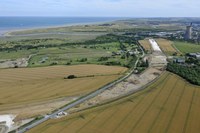 The archaeologists wondered if the ditch could be the defences of one of Julius Caesar's forts, but there were three problems with this idea. Firstly, for over a century it has been thought that Caesar landed at Deal, 15 km to the south. Secondly, in the Iron Age Thanet was an island, separated from the rest of Kent by the Wantsum Channel. Thirdly, no evidence for Julius Caesar's camps had ever been found in Britain. But the last full study of Caesar's invasions was over 100 years ago. What could a new study discover?
The archaeologists wondered if the ditch could be the defences of one of Julius Caesar's forts, but there were three problems with this idea. Firstly, for over a century it has been thought that Caesar landed at Deal, 15 km to the south. Secondly, in the Iron Age Thanet was an island, separated from the rest of Kent by the Wantsum Channel. Thirdly, no evidence for Julius Caesar's camps had ever been found in Britain. But the last full study of Caesar's invasions was over 100 years ago. What could a new study discover?
Thanks to a grant from the Leverhulme Trust the 'In the Footsteps of Caesar' project is re-examining the evidence for Caesar's invasions of Britain.
Return to Ebbsfleet
The 2010 excavations were done before a new road was built. The road cut across the ditch in two places, showing that the area it defended was at least 500 m long north–south. An Iron Age village in the northern part of this area seems to have been abandoned at the time the defences were built. There was no evidence for buildings anywhere else in the defended area.
New work at Ebbsfleet by the Leverhulme project involved geophysical surveys in 2015–16 and trial excavations in 2016–17. The geophysical surveys suggested two possible entrances and the excavations were designed to investigate these because they are the most likely place where objects might have been dropped and the find could reveal the nature and purpose of the enclosure.
The work has revealed the plan of the western part of the defended enclosure. The eastern limit is yet to be established, but is likely to lie under reclaimed land. It seems that the defensive ditch was dug in individual sections each about 75 m long. As a result the plan is rather irregular and the builders seem to have deliberately included the Iron Age village and also a low hill, Ebbsfleet hill, within the defences.
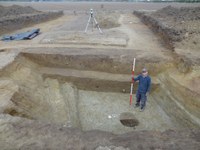 The ditch was dug to a standard: 5 m wide and 2 m deep, the walls sloping at 45 degrees and the base was flat. In each of the 9 sections excavated across the ditch, another smaller ditch was found, dating to the mid-first century AD.
The ditch was dug to a standard: 5 m wide and 2 m deep, the walls sloping at 45 degrees and the base was flat. In each of the 9 sections excavated across the ditch, another smaller ditch was found, dating to the mid-first century AD.
The site of one entrance was confirmed in 2017. Only part of the entrance area could be dug, but the excavations revealed that the causeway between the ditches was less than 3 m wide. The ditch was a little deeper at the entrance and the slope was steeper, closer to 65 degrees. No trace of a gate structure was found, but if there was one, it might have stood outside the excavated area. The road was surfaced with pebbles.
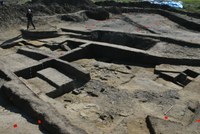 Several iron objects were found on the road surface. They are badly corroded and cannot be identified fully until conservation is complete, but they include a sword and at least two spearheads. Human bones were also found on the road surface. They come from at least two people and include thigh bones and arm bones, and fragments of skull. Some of the bones have cut marks made by weapons.
Several iron objects were found on the road surface. They are badly corroded and cannot be identified fully until conservation is complete, but they include a sword and at least two spearheads. Human bones were also found on the road surface. They come from at least two people and include thigh bones and arm bones, and fragments of skull. Some of the bones have cut marks made by weapons.
The possible second entrance was investigated in 2016, but here the ditch proved to be continuous. At its base, there was pottery of mid-1st century BC date, human and animal bone, and the tip of an iron weapon. Conservation has since shown that this fragmentary find was in fact the tip of a Roman spear or pilum, making it the most significant object yet recovered at Ebbsfleet.
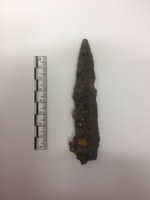 The Ebbsfleet defences also appear to be Roman in form. The flat-bottomed ditch is very similar in size and shape to Julius Caesar’s siege works at Alésia, France, where in 52 BC, he laid siege to the Gaulish fortress of Alésia, the site of the decisive battle in the Battle for Gaul. This type of ditch was used to enclose and defend large areas. The size and shape of the entrance at Ebbsfleet is similar to the western entrance of the Roman fort at Hermeskeil, Germany, which dates to 51 BC; here too, the excavation revealed no evidence for a gate structure.
The Ebbsfleet defences also appear to be Roman in form. The flat-bottomed ditch is very similar in size and shape to Julius Caesar’s siege works at Alésia, France, where in 52 BC, he laid siege to the Gaulish fortress of Alésia, the site of the decisive battle in the Battle for Gaul. This type of ditch was used to enclose and defend large areas. The size and shape of the entrance at Ebbsfleet is similar to the western entrance of the Roman fort at Hermeskeil, Germany, which dates to 51 BC; here too, the excavation revealed no evidence for a gate structure.
The camp of Quintus Atrius?
Julius Caesar does not say exactly where his army landed in 54 BC, saying only that it was 'the best place of disembarkation'. He does, however, give three important clues about it.
The first clue is contained in his account of the crossing. So that the army could embark and disembark in daylight the Roman fleet set sail from France in the evening. The plan was to use the wind to help them cross the Channel, but around midnight the wind dropped and the tide carried the fleet too far north. At sunrise they saw Britain a long way away on the port (left) side.
The second clue is in Caesar's description of the landing. He says that the Britons had gathered to oppose the landing. But taken aback by the size of the Roman fleet – 800 ships – they withdrew 'and concealed themselves on the high ground'.
The third clue is Caesar's description of the landing place. In separate passages, he says that this was the best place to land and that it had a soft or 'sandy, open shore.'
The site at Ebbsfleet occupies a finger of land projecting into the former Wantsum Channel, today nearly a kilometre from the sea at Pegwell Bay. However, in the 13th century AD, the sea was just 500 m away – the medieval sea defence still survives – so it seems very likely that in the 1st century BC the sea came right up to the east side of the Ebbsfleet peninsula.
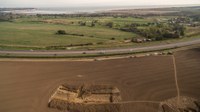 Pegwell Bay is a large flat, sandy bay, the largest of this type on the east Kent coast. The north end of the bay is formed of chalk cliffs that rise up to higher ground inland. The south is formed by the mouth of the Wantsum Channel, where the River Stour flows into the sea. The Wantsum Channel was once a wide marshy area, but it was systematically reclaimed in the medieval period and today is an area of flat, low-lying land.
Pegwell Bay is a large flat, sandy bay, the largest of this type on the east Kent coast. The north end of the bay is formed of chalk cliffs that rise up to higher ground inland. The south is formed by the mouth of the Wantsum Channel, where the River Stour flows into the sea. The Wantsum Channel was once a wide marshy area, but it was systematically reclaimed in the medieval period and today is an area of flat, low-lying land.
The clues that Caesar gave about where his fleet landed all point to Pegwell Bay, not far from Ramsgate. It is common knowledge that a sailor in a small boat some way out to sea can only see high ground. When Caesar said that 'at sunrise he sighted Britain left afar on the port side' he must have been describing high ground. The land to the south of Pegwell Bay is low-lying; further north is the Thames Estuary and beyond that the low-lying coast of East Anglia.
The only high ground on this part of the coast is formed by the chalk cliffs north of Pegwell Bay. It is possible that Caesar saw these white cliffs illuminated by the rising sun. The open shore where he landed is also consistent with Pegwell Bay. With 800 ships and an army of perhaps 20,000 men and at least 2,000 horses to land in a single day it was Caesar's 'best place of disembarkation.' And the higher land of Thanet is the only higher ground in the area to which the Britons could withdraw.
Caesar's clues and the remains discovered at Ebbsfleet all point it being the site of the fort whose role was to protect the fleet. The galleys would have been hauled ashore but the transports were riding at anchor when a storm caused them to break their anchors and collide with one another before they were cast up on shore. On receiving news of the disaster Caesar led his army back to the fleet. He decided to beach all the ships and protect them by a trench that joined with the camp, tasks that took the army 10 days and nights, after which Caesar returned to the campaign. Caesar tells us that Quintus Atrius was in charge of the garrison left behind to protect the fleet.